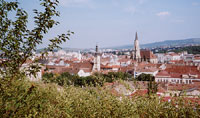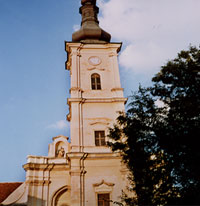See Exotic Eastern European Architecture in Romania
The
grandmother becomes more and more agitated
as the train lurches towards the Hungarian-Romanian
border. Tears leak into the furrows around
her blue eyes. She clutches my hands. "Help
me, help me," she begs in crude German,
our only common language. I nod, terrified.
She
bustles around the compartment. Bunica - that's
the local word for granny - secrets a chocolate
bar under my newspaper, rams a container of
Viennese coffee into my duffel bag. "You're
a foreigner. The police won't take your things,"
she explains, detailing all the border-thefts
she has suffered. Though Romanian, she works
in a brassiere factory in Austria, returning
once a year to her family. I am smuggling
her excess treats.
At
least, I sincerely hope they are treats, not,
say, cafe canisters crammed with cocaine.
The train jerks through the ink-dark countryside.
We stop frequently. Boots slam up and down
the carriage. I pretend to doze, blue passport
displayed ostentatiously. Bunica croons and
rocks, hyperventilating slightly. I begin
to hate her. Why did she pack 12 jars of instant
espresso anyway? The Cold War is over. Supplies
cross the border in happy, capitalist fashion.
Did she miss the memo?
The
grim guards finally materialize. They glance
briefly at my documents, amused by a tourist
on the Budapest-Cluj night service. Then they
ransack Bunica's bags. She weeps. I watch
sternly, doing my best U.N. Human Rights Officer
impression. Perhaps it works: the border thugs
leave her chocolate hoard in peace.
Bunica
kisses me and dances around the compartment.
Then she prepares a celebratory coffee from
her stash, mixing the brown powder with fizzy
mineral water. "Mmmmm. Gut!" she
declares, shaking the bottle. I choke down
the tepid mixture - quite possibly the worst
beverage of my entire life - and toast my
first trip to Eastern Europe.
The
gritty, pokey train, rumors of crooked cops,
stained concrete-slab apartment blocks and
impassable, pot-holed roads were everything
I expected from a nation ravaged by a corrupt
Communist dictator. In three short decades,
Nicolae Ceausescu unraveled centuries of pastoral
prosperity and Austro-Hungarian high culture.
He dined on gold plates while the people starved,
encouraged children to spy on their relatives
and allegedly funneled $470m into his private
Swiss account. Despite his execution in 1989,
the money has never been recovered.
That's
a shame, because Romania deserves some pocket
change and a reason to smile. Once I pushed
through the raw culture shock (the rusted
metal, the spavined orphans, the pleading
glassware peddlers in horse carts), I found
much to like, enjoy even. Cluj for starters.
 Gothic,
Baroque and fin-de-siècle buildings
cluster together along a winding river. The
colors are warm: honey-yellow, pastel pink,
robin-egg blue, even sunset orange, revealing
the area's showy Latin roots. Spires and onion-domes
soar above cobbled courtyards. Literary salons
and cafe culture once held sway here, when
the city's light illuminated the Balkans.
Gothic,
Baroque and fin-de-siècle buildings
cluster together along a winding river. The
colors are warm: honey-yellow, pastel pink,
robin-egg blue, even sunset orange, revealing
the area's showy Latin roots. Spires and onion-domes
soar above cobbled courtyards. Literary salons
and cafe culture once held sway here, when
the city's light illuminated the Balkans.
Cluj
is also an outpost for Transylvania-bound
travelers. I rent a clapped out Mercedes sedan,
quite possibly older than me, and head for
the hills - or rather the mist-shrouded Carpathian
Mountains.
The
countryside seems weirdly deserted...and so
it is. After Ceausescu's fall, anyone with
German lineage could claim German citizenship.
Ninety percent of Transylvanians emigrated.
Exodus
and identity crisis is nothing new in this
Saxon swathe of land, settled in the 12th
century. The Hungarians, Germans, Turks and
Hapsburgs all laid claim - and waste - to
the area.
 The
sad remainders eke out medieval lives, complete
with stout churches and oxen hitched to hay
carts. Kilns burn limestone. Professions are
handed from father to son: blacksmith, woodcarver,
butcher. Elders trundle down dirt tracks,
spines bowed under heavy bundles of kindling.
Shepherds sell round cheese, beside Magyars
peddling traditional embroidery and stout
fleece vests. Their liquor of choice is fierce
homemade brandy - called tsuica or horinca
- flavored with plum.
The
sad remainders eke out medieval lives, complete
with stout churches and oxen hitched to hay
carts. Kilns burn limestone. Professions are
handed from father to son: blacksmith, woodcarver,
butcher. Elders trundle down dirt tracks,
spines bowed under heavy bundles of kindling.
Shepherds sell round cheese, beside Magyars
peddling traditional embroidery and stout
fleece vests. Their liquor of choice is fierce
homemade brandy - called tsuica or horinca
- flavored with plum.
Tiled
roofs slump, the red clay dragged back towards
the earth. Lace curtains flap, revealing solemn
furniture - all dark wood and heavy carvings.
Oak-shingled church spires preside over villages
that have never known pavement.
The
land is torn into canyons, peaks and cliffs,
barnacled with castles. Broad river valleys
rustle with orchards, bears and wild boars.
The scenery is show stopping; a small wonder
Anthony Minghella shot Cold Mountain among
these crags.
Bram
Stoker captured the essence of the haunting
landscape and distilled it into the Dracula
myth. Ironically, he never ventured into the
Carpathians. His vivid descriptions were cobbled
together from guidebooks in the British Museum
Reading Room.
The
vampire count was based on a fifteenth century
prince, Vlad Tepes, who was merely blood thirsty
in a conventional battle-crazed sense. He
slaughtered thousands of Turkish invaders,
often impaling victims or mounting their heads
on pikes. The Transylvanian town Brasov plays
up the gory story, but general consensus dismisses
"Dracula's castle" as a cheesy tourist
trap.
Really
Ceausescu sucked far more life from this once-prosperous
nation, a Balkan breadbasket. His smoked-smeared
factories and crumbling nuclear reactors still
blot the emerald countryside. Orphans roam
the streets begging and sniffing glue, thanks
to his anti-contraception, baby-pushing policies.
Even from the grave, his shadow looms.
But
the country's heart shines through the murk.
The people are wise, deep and generous, prone
to merry outbursts. Their spirit burns bright.
In
the grip of the Reformation and its Spartan
style, the Transylvanians whitewashed their
church wall paintings. Yet over the centuries,
the chalk dissolved. Outlines, then details,
emerged ...and now the stunning Medieval frescoes
glow, restored and revived.
May
Romania do the same.
IF
YOU GO: |
Transport
:
Austrian Air flights
from New York to Bucharest, Timisoara
or Cluj (www.austrianair.com).
Expect to pay more for a five-mile cab
ride into the center of Cluj, also called
Cluj-Napoca, the best jumping-off point
for Transylvania. The #8 bus runs from
the aiport to Piata Mihai Viteazul)
The
direct train from Budapest to Cluj takes
about nine hours (reservations are highly
recommended. Smuggling is not). From
the station, it's a twenty-minute walk
to the bustling main square, Piata Unirii.
Arrange
an affordable car rental from Pacr-auto
(Tel: 0265-443-297; English spoken).
Be braced for rough, pot-holed roads,
lengthy construction delays and long
lines for fuel, however.
Where
to stay :
Splurge
on Transylvanian glamour at Miklósvár
(aka Miklosoara), a frescoed hunting
manor from the 1500s. Excursions include
carriage rides, birdwatching, bear tracking
and hikes to the Almas Cave, which supposedly
sheltered the Pied Piper ( Tel:742.202.586. www.transylvaniancastle.com).
Experience
Romanian hospitality and authentic country
conditions (read "lack of indoor
plumbing" there) through the National
Association of Rural, Ecological and
Cultural Tourism. (ANTREC, Strada Maica
Alexandra 7, Sector 1, Bucharest, Post
Office Box 22-259. Tel: 122.370.24. www.antrec.ro).
The
Retro Youth Hostel boasts constant hot
water, tidy new bathrooms and Internet
access. (Potaissa St. 13, Cluj-Napoca.
Tel: 0264-450452. www.retro.ro).
Where
to eat :
Like
their distant cousins in Italy, Romanians
turn out good pizzas. Gente Senior serves
pasta and pies in a cheerful atmosphere...cheerful
by local standards, where customer service
is not yet highly prized (Horea St.
5, Cluj. Tel: 0264-13204).
Cabbage
is the (unlikely) star at Varzaria.
Sample a soup, pie or the regional delicacy:
rice, sour cabbage, mince and sour cream
simmered in the oven (Varza a la Cluj).
The decor won't impress, but the tiny
check might (B-dul Eroilor 35, near
the Orthodox Cathedral).
Information:
The
Romanian National Tourist Office provides
glib and glossy information (14 East
38th Street, 12th Floor, New York, NY
10016. Tel: 212-545-8484. www.romaniatourism.com).
Travelers bemoan Cluj's tourist office:
recently privatised, it hustles package
holidays and skimps on the free local
advice. Try your luck at Sincai 2, on
the corner of Strada Memorandumului,
the main road west from Piata Unirii.
Cluj
is home to Europe's largest botanical
garden, founded in 1921. Over 10,000
species grace the sprawling grounds
(42 Gheorghe Bilascu. Tel: 264.597.604). |